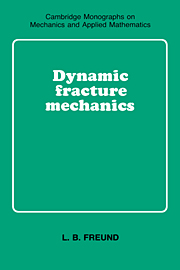Book contents
- Frontmatter
- Contents
- Preface
- List of symbols
- 1 Background and overview
- 2 Basic elastodynamic solutions for a stationary crack
- 3 Further results for a stationary crack
- 4 Asymptotic fields near a moving crack tip
- 5 Energy concepts in dynamic fracture
- 6 Elastic crack growth at constant speed
- 7 Elastic crack growth at nonuniform speed
- 8 Plasticity and rate effects during crack growth
- Bibliography
- Index
5 - Energy concepts in dynamic fracture
Published online by Cambridge University Press: 03 October 2009
- Frontmatter
- Contents
- Preface
- List of symbols
- 1 Background and overview
- 2 Basic elastodynamic solutions for a stationary crack
- 3 Further results for a stationary crack
- 4 Asymptotic fields near a moving crack tip
- 5 Energy concepts in dynamic fracture
- 6 Elastic crack growth at constant speed
- 7 Elastic crack growth at nonuniform speed
- 8 Plasticity and rate effects during crack growth
- Bibliography
- Index
Summary
Introduction
Analytical methods based on the work done by applied loads and the changes in the energy of a system that accompany a real or virtual crack advance have been of central importance in the development of fracture mechanics. These methods have provided a degree of unification of seemingly diverse ideas in fracture mechanics, and they have led to procedures of enormous practical significance for the characterization of the fracture behavior of materials. In addition, some of the most elegant theoretical analyses in the field have been those associated with energy methods. In this chapter, energy concepts that are particularly relevant to the study of dynamic fracture processes are considered.
The importance of the variation of energy measures during crack growth was recognized by Griffith (1920) in his pioneering discussion of brittle fracture, as outlined in Section 1.1.2. The extension of a crack requires the formation of new surface, he reasoned, with its associated surface energy. Consequently, a crack in a brittle solid should advance when the reduction of the total potential energy of the body during a small amount of crack advance equals the surface energy of the new surface thereby created. For an elastic body containing a crack, the negative of the rate of change of total potential energy with respect to crack dimension is called the energy release rate. This quantity, which is usually denoted by the symbol G, is a function of crack size, in general.
- Type
- Chapter
- Information
- Dynamic Fracture Mechanics , pp. 221 - 295Publisher: Cambridge University PressPrint publication year: 1990
- 1
- Cited by

